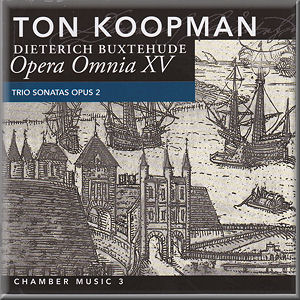 |
 |
|


alternatively
CD: MDT
AmazonUK
AmazonUS
|
Dieterich BUXTEHUDE
(1637/1639?-1707)
Opera Omnia XV - Chamber Music 3
Trio sonatas op. 2
B flat nr.1 BuxWV 259 [8:27]
D nr.2 BuxWV 260 [14:16]
g nr. 3 BuxWV 261 [13:18]
c nr. 4 BuxWV 262 [8:19]
A nr. 5 BuxWV 263 [10:41]
E nr. 6 BuxWV 264 [9:30]
F nr. 7 BuxWV 265 [8:51]
 Catherine Manson (violin); Paolo Pandolfo (viola da gamba); Mike
Fentross (lute); Ton Koopman (harpsichord, organ)
Catherine Manson (violin); Paolo Pandolfo (viola da gamba); Mike
Fentross (lute); Ton Koopman (harpsichord, organ)
rec. December, 2010, October, 2011, Waalse Kerk, Amsterdam, Holland.
DDD
 CHALLENGE CLASSICS CC72254 [73:27]
CHALLENGE CLASSICS CC72254 [73:27]
|
|
|
Poor Buxtehude! In his excellent "Bach: Essays on His Life
and Music" [ISBN-13: 978-0674059269] Christoph Wolff makes
the point that Buxtehude is a much greater, more universally
relevant, and certainly more influential composer than is usually
accepted. He even takes Kerala J. Snyder gently to task for
subtitling her book "Dieterich Buxtehude: Organist in Lübeck"
[ISBN-13: 978-1580462532] as she does. He was so much more than
an organist. Sadly the earlier composer's discography
has still only fared a little better than was the case when
Wolff was writing - almost twenty years ago.
At the head of what ought to be a veritable revival of Buxtehude - whose music, Wolff shows, comprises almost all genres current in the seventeenth century - is the series on Challenge directed by Ton Koopman. When complete, it will probably comprise in the region of two dozen CDs and CD sets; these will contain all the extant works. In the excellent booklet Koopman states that this is the final volume of the chamber music and that only a 'number of vocal challenges' remain. That in itself would be an amazing achievement. It ought to encourage us: there's a place for ambitious series like this in what is still a somewhat recherché area of the repertoire. That the music-making should be of such a high quality is what counts, though ... and it is! One of the first things you'll notice after you're struck by the just and positive response to the buoyancy, vivacity and delicately uplifting tenor of the music is its variety. These are substantial forward-paced pieces though none lasts less than eight and a half minutes.
Buxtehude varies texture, melody, rhythm and tempi - often within one movement … as in the opening of the delicious Op. 2, nr. 3 (BuxWV 261) [tr.3]. His ideas never run on the spot and never seek a dull centre. At the same time, in the hands of these accomplished experts, no nuance is overlooked; no subtlety underplayed. The music sounds as natural, free-flowing and inevitable in direction as any by Bach.
In the same booklet with this CD, Wolff leads us through the publishing history of these works; sadly he has to allude to possibly lost works. Interestingly, the present sonatas were intended for use both liturgically and as secular entertainment ('zur Kirchen und Tafel-Music'). Published in 1696 this Op. 2 set is as stimulating, adventurous and deeply satisfying a collection of small-scale sonatas as you could wish for. While in places Corelli's influence is unmistakable, they are firmly in the north German idiom; pure Buxtehude. The composer's inventiveness, facility with melody and the quasi-improvisatory and delightfully exciting stylus phantasticus are matched by technical brilliance. There’s a fully expressive command of textures which the strings and plucked instruments can each make. These sound beautiful and compelling together - and in 'conversation' such as towards the beginning of the 3/4 poco adagio of the sonata in C, BuxWV 262 [tr.4].
As has been remarked in earlier reviews of this cycle, Koopman seems to have 'loosened' a little in his playing style as he has moved deeper into the repertoire. There is almost a 'swing' - certainly a gentle lilt - to some of the movements. The players bow and pluck in a persuasive unison. Their aim is wholly interdependent: to expose the most from this marvellous music. They succeed in every regard.
Whether or not the musicians are helped by the fact that these sonatas are constructed as multi-sectional units, rather than from discrete movements is hard to say but it seems likely. The architecture is clearer. One senses that the momentum which is generated so amply and which so positively reinforces the impact of this music would have been brought out of any format, though - so gifted and in tune with the idiom are the four musicians here, and so extremely well do they play together.
The asymmetrical dynamics employed almost throughout by Buxtehude surely adds to our interest. Again Manson, Pandolfo, Fentross and Koopman - all of whom have featured on earlier releases in the Challenge series - are on top of their form. They clearly love the music. They have the will, technique, interpretative impetus and precision to offer an analogous response to the listener.
Anyone already collecting the series will want to buy this CD immediately. However its appeal is surely much wider: to have heard the name of Buxtehude and paid it lip service is not enough. Jump in here and see what's so special about his creativity and originality. Here is a composer who is able to see invention through to profoundly pleasing results.
As has been the case throughout the series, the acoustic is entirely responsive. There is atmosphere without undue addition. The strings sound rich and approachable, the harpsichord and lute contained and constant. In the useful biographies in the booklet that of Pandolfo describes his belief that ancient music can be a 'powerful inspiration' for the future. It's hard not to be in accord when music-making of this quality, weight and insight is made. It’s all done without fuss or undue emphasis on - a still much needed - advocacy for an overlooked genius. Do not miss this issue.
Mark Sealey
|
|

